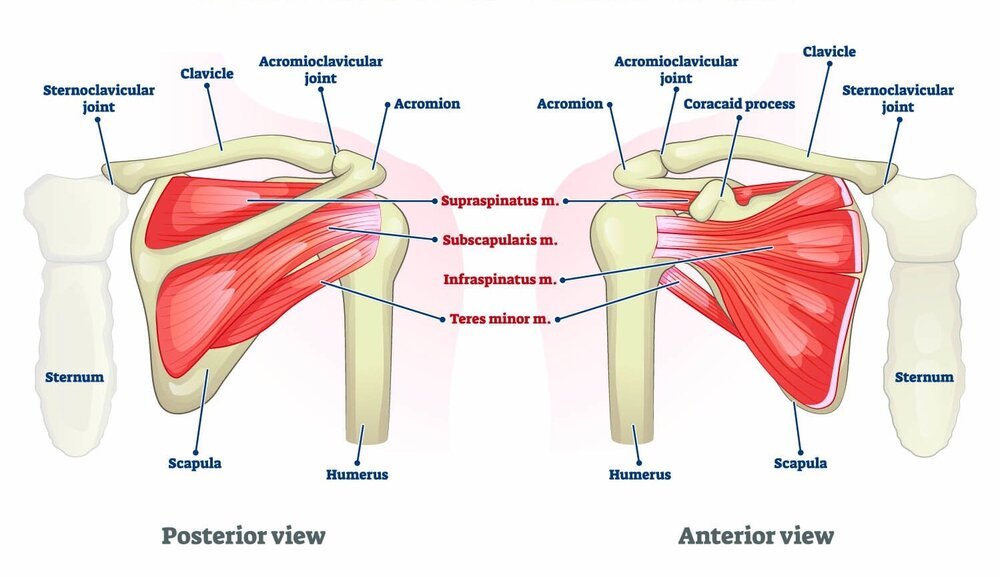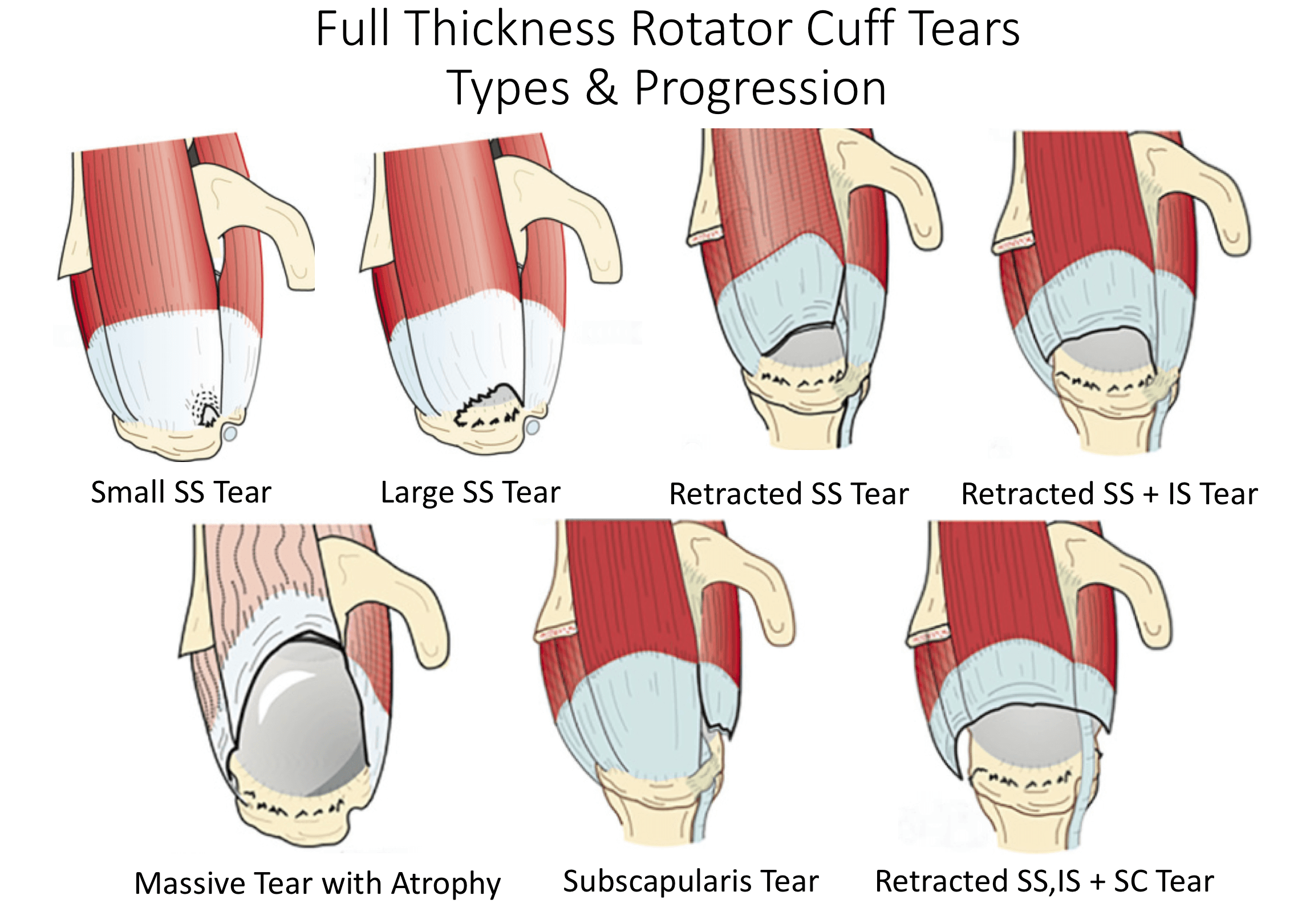Rotator Cuff Surgery
Surgery to repair a torn rotator cuff most often involves re-attaching the tendon to the head of humerus (upper arm bone). In an “all arthroscopic” rotator cuff repair, like those performed by our orthopedic surgeons at Aptiva Health, utilizes small cameras and minimally invasive surgical techniques to make small incisions rather than larger incisions seen in open techniques.
Anatomy of Rotator Cuff
The rotator cuff is a group of muscles and tendons that keep the shoulder joint stable. These muscles also allow the shoulder to rotate safely. Your shoulder is a ball-and-socket joint. The “ball” is the head of the humerus (upper arm bone). It fits into the “socket” of your shoulder blade.
The rotator cuff contains four muscles:
Supraspinatus controls internal rotation and lifting of the arm.
Infraspinatus allows you to externally rotate your arm in the shoulder socket.
Teres minor is a small muscle that helps rotate your arm.
Subscapularis controls arm abduction (holding your arm out straight, away from your body).
The muscles start at the shoulder blade. Tendons (strong bands of tissue) attach the muscles to bones. The tendons wrap around the head of the upper arm bone, forming a cuff that keeps your arm in the shoulder socket.
Types of Rotator Cuff Tears
One or more tendons in the rotator cuff may tear, if the injury is untreated and activity continues, then the tear may worsen. It is important to receive proper treatment to allow the rotator cuff to function optimally.
The different classification of rotator cuff tears include:
Partial tear: The tendon of the rotator cuff is damaged, but not completely severed.
Complete tear: The soft tissue is torn into two separate pieces. The tendons frequently tear away from where they are attached at the humerus (upper arm bone).
Acute tear: These tears are caused by injury/trauma, such as a fall or lifting something too heavy too quickly or awkwardly.
Degenerative tear: Most rotator cuff tears are multifactorial in origin and occur from a gradual wearing down of the tendon over time as well as genetics, and other medical conditions such as diabetes or high cholesterol. Because of this, tears are more common in the dominant arm due to the higher level of repetitive stress it experiences. Degeneration also occurs naturally as we age, increasing a likelihood of injury over time.
Symptoms of Rotator Cuff Tear
The most common rotator cuff tear symptoms include:
Pain over the lateral aspect of the upper arm (policeman’s patch area)
Pain while resting and at night, especially if sleeping on the injured shoulder
Discomfort when lifting or lowering the arm in specific ways
Weakness when rotating the arm
A cracking or popping sensation when moving the arm in certain positions
If the tear is a degenerative one that develops over time, then the symptoms may also progress gradually. Eventually it may become difficult to perform normal daily task using the shoulder muscles. If you are experiencing these symptoms, you should talk to your orthopedic surgeon immediately.
Treatment Options
There are a number of different treatment options that share a singular goal to restore function and reduce pain. One of our orthopedic surgeons will recommend treatment according to a patient’s preferences, medical history, and the condition of the tear.
Treatment options include:
Rest - Limiting arm usage, particularly overhead movements which put strain on the joint. A sling may be recommended for additional protection and rest.
Activity modification - Avoiding activities and changing routines that cause pain in the joint.
Medication - Anti-inflammatory medication can help reduce pain and swelling.
Physical Therapy - Using specific exercises to target muscles in the shoulder to provide additional strength and support restoring movement, reducing pain, and helping to prevent further injury. Stretching exercises will also help to restore flexibility.
Steroid injection - If the other methods are not effective, then an injection of local anesthetic and cortisone may be injected into the shoulder to reduce inflammation and allow healing.
Surgery - If non-surgical methods prove insufficient, then minimally invasive rotator cuff surgery may be recommended.
Minimally Invasive Rotator Cuff Repair
During a minimally invasive rotator cuff repair, your orthopedic surgeon will insert a small camera, called an arthroscope, into the shoulder joint. The camera displays pictures on a television screen, and your surgeon uses these images to guide miniature surgical instruments. Due to the incredibly small size of the arthroscope and because the surgical instruments are thin, your surgeon can use very small incisions (cuts), rather than the larger incision needed for standard, open surgery. Another benefit to an all-arthroscopic repair is that it can be performed as an outpatient procedure and is the least invasive method to repair a torn rotator cuff.
Post-Operative Recovery
Post-operative recovery from an arthroscopic rotator cuff repair will occur in a few different stages. The first step following surgery is to effectively manage your post-operative pain. Although your arm will likely be immobilized in a sling for the first four to six weeks after the surgery, you may be able to return to most of your normal activities within a few days of surgery. You will be able to drive and walk, but remember you will be doing these things with one arm.
During your recovery period, you will work with your physical therapy team at Aptiva Health to regain motion and strengthen the shoulder. The rotator cuff surgery recovery timeline is individualized and can vary between patients, but for the most part, a full recovery typically takes four to six months. It may take longer than this period to return to heavy lifting or very strenuous activity and this will be determined on an individualized basis. We always encourage you to communicate directly to your surgeon and physical therapy team before resuming any workout routines or going back to a job that will put significant strain on your shoulder.
For more information, take a look at our post-operative protocols following your minimally invasive rotator cuff surgery.
Post-Operative Physical Therapy
Active participation in post-operative rehabilitation with your Aptiva Health physical therapy team is crucial to having a successful outcome from your rotator cuff repair. According to Dr. Smith, “physical therapy is likely the biggest part of postoperative rotator cuff treatment.” Your physical therapy team will start by introducing passive motion to the shoulder. They will carefully move your arm for you to ensure the recovering muscles and tendons are not under excessive strain. When you are ready, your physical therapy team will slowly progress to active motion, which means your therapy team will instruct you how to move your arm. Finally, you will begin to work on strengthening the shoulder with resistance exercises. While you will have regularly scheduled physical therapy appointments, your therapy team will likely give you daily at-home exercises to complete to ensure optimal recovery. Rotator cuff tear rehabilitation will usually last four to six months following surgery.








